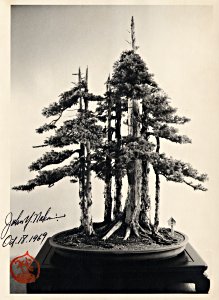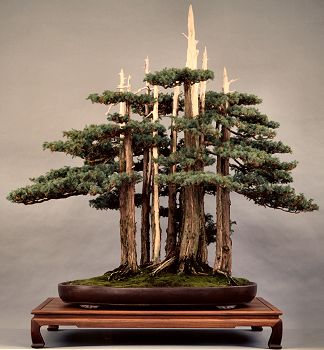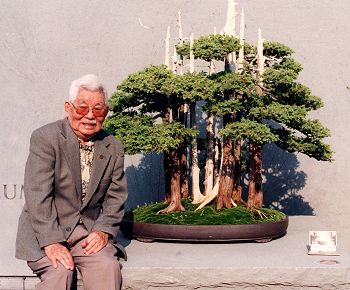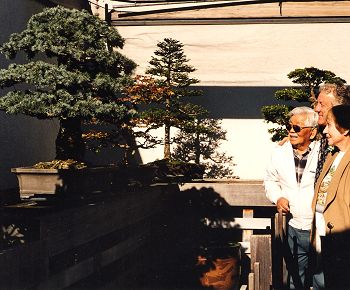
Goshin, 7-tree version Larger version
But this collection of trees in individual pots was taking up too much space on the bench. So in 1963, John had the brilliant idea of putting them in one pot to make more space on his bench for other trees. He'd fondly remembered a cryptomeria forest near a shrine in Japan and wanted to emulate the feeling of those majestic trees in his new creation. His friend Mas Imai had many foemina junipers and offered him three more so he could make a seven-tree group planting. But soon the number-six tree died. Its replacement also died, as did several more replacements. So John carefully examined the pot and noticed that the number-six tree was too far from the drainage hole. He chipped and then drilled on the pot to create life-giving drainage just below number six. Now the seven-tree forest planting was the picture of health.

John was quite proud of his forest planting. George Yamaguchi, Richard Ota, and several other friends encouraged him to name it. John thought of the qualities of the forest near the shrine that had inspired him to create the group – venerable, holy, solemn, and sublime. And the perfect name that came to mind for this special bonsai was Goshin, Japanese for "protector of the spirit." The initial planting had only seven trees, and at the time John had only seven grandchildren. He was as proud of his grandchildren as he was his forest. One day John's oldest grandchild asked "Which tree is me?" John replied, "You may not be happy because the oldest one is the smallest one." But his grandchild was quite content, because John had always said to him that the two most important trees in the forest are the smallest and the largest. By 1976, John had four more grandchildren, so Goshin grew to be an eleven-tree forest planting.

Goshin made its debut at the Descanso Gardens during the dedication of Van de Kamp hall. It was twice displayed at the Philadelphia flower show. And in 1984, Goshin became the centerpiece of the John Naka North American Pavilion of Bonsai at the Arboretum in Washington, D.C. John made many annual trips to the Arboretum to visit his old friend. Crowds always gathered to see him work on his masterpiece: a bonsai that can be traced back to the very beginning of John's professional bonsai career.

|

|
|
|
John Naka and Goshin, May 2003.
Details and larger version |
John at the National Arboretum.
Details and larger version |
[ Top of page | Go back | Go forward | "Profiles in Bonsai" contents | Site contents | Home | ]